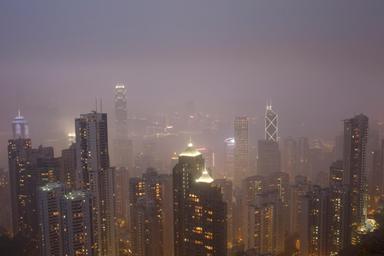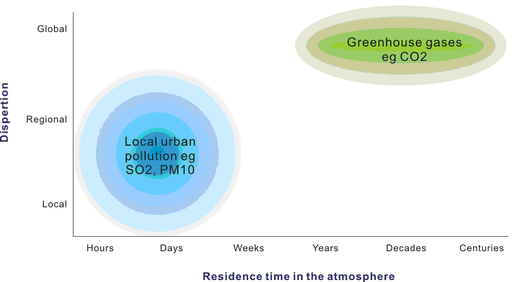> CO2 and Climate Change
Air Pollution VS Climate Change
Air Pollution in Hong Kong
According to the Environmental Protection Department (EPD), Hong Kong has been faced with two main air pollution issues. The first, is local street-level pollution while the other is regional smog. Diesel vehicles are the main source of street-level pollution. Smog, however, is caused by a combination of pollutants from motor vehicles, industry, and power plants both in Hong Kong and in the Pearl River Delta region.
The Environmental Protection Department releases hourly information to inform the public about air pollution levels. The API transforms the air quality data measured at monitoring stations into a single number ranging from 0 to 500. Higher values indicate higher levels of pollution. An API forecast also advises the public before the onset of high air pollution levels, which can be potentially harmful to the public.

Hong Kong’s air-quality objective for particulates is 180, but the World Health Organization guideline is 50. Hong Kong’s Air Pollution Index (API) however, is based on the government’s own standards (“Air Quality Objectives”) for air quality management. There are arbitrary lines above or below which air quality is considered good or poor. These standards are based on outdated evidence of the effects of air pollution. The API does not tell you about the real health risks or the avoidable health problems that people face because of air pollution.
Burning fossil fuels creates local air pollution. It also creates greenhouse gases (GHGs) which increase the risk of dangerous climate change. While these problems have the same source their impact is different – see the box on the following page. What is certain is that air pollution and climate change are serious risks to our present and future quality of life and the way we do business.
Local Air Pollution is an immediate, local and regional problem. Further more, worldwide research has confirmed air pollution damages public health. The deterioration of Hong Kong’s air quality has resulted in a steady increase in the number of hazy days and the associated reduced visibility.
Local sources are a significant contributor to Hong Kong’s pollution

According to a paper written by HKUST for Civic Exchange, during 2006 regional sources were the primary influence on Hong Kong’s air pollution for 132 days (approximately 36% of the time) while local sources (including vehicles, marine and power plants) were the primary influence on 192 days (nearly 53% of the time).
Based on these results, it is clear that reducing emissions of air pollutants in Hong Kong would have a significant positive impact on local air quality, which would in turn improve public health. In 2008, the number of hours for which street-level pollution exceeded the danger level in some of the city’s busiest districts rose by 14%, according to Environmental Protection Department (EPD) figures. In addition, Hong Kong’s infrastructure and “canyon-like” streets are an important cause of pockets of very high levels of urban pollution.
Greenhouse gases (GHGs) and Air Pollutants
Local air pollutants are substances, such as sulphur dioxide (SO2), nitrogen dioxide (NO2), respirable suspended particulates (a.k.a. particulate matter, specifically PM10 and PM2.5) volatile organic compounds (VOCs), ground-level ozone (O3), and carbon monoxide (CO) that are present in the atmosphere and are potentially harmful to health. Sources of these pollutants include car exhaust, fossil fuel combustion, and chemical reactions between other pollutants in the atmosphere – such as photochemical smog.
Greenhouse gases (GHGs) are six principal gases identified by the United Nations Framework Convention on Climate Change (UNFCCC) - carbon dioxide (CO2), methane (CH4), nitrous oxide (N2O), hydrofluorocarbons (HFCs), perfluorocarbons (PFCs), and sulphur hexafluoride (SF6). These are the gas that are associated with climate change.

Many air pollutants and greenhouse gases (GHGs) have common sources; their emissions may interact in the atmosphere and separately or jointly they cause a variety of environmental impacts on local, regional and global scales. Implementing climate policies, for example in order to achieve greenhouse gas (GHG) emissions targets, can significantly reduce the costs of meeting air quality targets and vice versa.
There are many reasons why climate change is a more difficult problem to solve than local air pollution. One is that it is a global problem, and greenhouse gas emissions do not respect international boundaries.If a country increases or decreases its carbon emissions, it won’t necessarily see a co-related effect on its local climate variation. It also takes a long time before greenhouse gases (GHGs) are absorbed into the sea and soil, this means that even if greenhouse gas emissions were to cease immediately, temperatures would continue to rise for at least 30 years, and sea levels for the next 100 years. Another main reason climate change is a more difficult problem to solve than local air pollution is that people cannot see the damage it is doing. It is a colourless and odourless gas and some consequences of the gas accumulation may take decades to appear.
Hedley Environmental Index
The Hedley Environmental Index is the world’s first web-based tool to monitor real-time economic costs of Hong Kong’s air pollution in terms of human health and monetary impacts. The Index reports that air pollution in Hong Kong costs approximately HK$ 1 Billion resulting from 447 premature deaths, 34,150 total hospital bed days and 3,341,924 doctor visits in 2011. A cumulative calculation of the five years from January 2006 to January 2011 show costs of an alarming HK$10.8 billion, from 5067 premature deaths, 370,380 avoidable hospital bed days and 34.5 million avoidable doctor visits.
Source: CCBF - Climate Change Business Forum
<< Previous page
---
Next page >>
TOP
|






